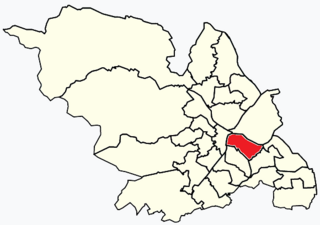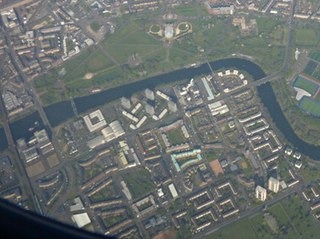
A tower block, high-rise, apartment tower, residential tower, apartment block, block of flats, or office tower is a tall building, as opposed to a low-rise building and is defined differently in terms of height depending on the jurisdiction. It is used as a residential, office building, or other functions including hotel, retail, or with multiple purposes combined. Residential high-rise buildings are also known in some varieties of English, such as British English, as tower blocks and may be referred to as MDUs, standing for multi-dwelling units. A very tall high-rise building is referred to as a skyscraper.

Manor Castle ward—which includes the districts of Claywood, Manor, Manor Park, Park Hill, and Wybourn—is one of the 28 electoral wards in City of Sheffield, England. It is located in the eastern part of the city and covers an area of 5.4 km2 (2.1 sq mi). The population of this ward in 2001 was 21,000 people in 9,700 households, the population increasing to 21,223 at the 2011 Census. It is one of the wards that make up the Sheffield Central constituency.

Park Hill is a housing estate in Sheffield, South Yorkshire, England. It was built between 1957 and 1961, and in 1998 was given Grade II* listed building status. Following a period of decline, the estate is being renovated by developers Urban Splash into a mostly private mixed-tenure estate made up of homes for market rent, private sale, shared ownership, and student housing while around a quarter of the units in the development will be social housing. The renovation was shortlisted for both the 2013 and 2024 RIBA Stirling Prize, for the first and second phases of the redevelopment respectively. The Estate falls within the Manor Castle ward of the City. Park Hill is also the name of the area in which the flats are sited. The name relates to the deer park attached to Sheffield Manor Lodge, the remnant of which is now known as Norfolk Park.

Walkley is an electoral ward in Sheffield, South Yorkshire, England.

Hutchesontown is an inner-city area in Glasgow, Scotland. Mostly residential, it is situated directly south of the River Clyde and forms part of the wider historic Gorbals district, which is covered by the Southside Central ward under Glasgow City Council.

Market Estate is a public housing estate consisting of 271 flats and maisonettes situated to the north of Caledonian Park in the London Borough of Islington. It is named after the Metropolitan Cattle Market which operated on the site until the 1960s. After slaughter the carcasses of cattle and sheep were sent by underground trains to Smithfield Market to be traded. Three of the six blocks that make up the estate are named after breeds of animal that were traded in the market: Tamworth (pigs), Kerry (cows) and Southdown (sheep). The remaining three blocks are called the Clock tower blocks after the market's clock tower which still stands in Caledonian Park. This contains a working clock used as a prototype for the mechanism of Big Ben.
The Sheffield Cricket Club was founded in the 18th century and soon began to play a key role in the development of cricket in northern England. It was the direct forerunner of Yorkshire County Cricket Club and some of the teams fielded by Sheffield were styled Yorkshire. Sheffield generally held first-class status, depending on the quality of their opponents, from 1827 to 1855.

The following is an overview of Public housing estates in Kwai Chung, Hong Kong, including Home Ownership Scheme (HOS), Private Sector Participation Scheme (PSPS), Sandwich Class Housing Scheme (SCHS), Flat-for-Sale Scheme (FFSS), and Tenants Purchase Scheme (TPS) estates.

The following is a list of public housing estates in Chai Wan and Siu Sai Wan, Hong Kong, including Home Ownership Scheme (HOS), Private Sector Participation Scheme (PSPS), Sandwich Class Housing Scheme (SCHS), Flat-for-Sale Scheme (FFSS), and Tenants Purchase Scheme (TPS) estates.
The following is a list of public housing estates in Fanling Town, Hong Kong, including Home Ownership Scheme (HOS), Private Sector Participation Scheme (PSPS), Sandwich Class Housing Scheme (SCHS), Flat-for-Sale Scheme (FFSS), and Tenants Purchase Scheme (TPS) estates.

The following is a list of Public housing estates in Ma On Shan, Hong Kong, including Home Ownership Scheme (HOS), Private Sector Participation Scheme (PSPS), Sandwich Class Housing Scheme (SCHS), Flat-for-Sale Scheme (FFSS), and Tenants Purchase Scheme (TPS) estates.
The following is a list of public housing estates in Shau Kei Wan, Hong Kong, including Home Ownership Scheme (HOS), Private Sector Participation Scheme (PSPS), Sandwich Class Housing Scheme (SCHS), Flat-for-Sale Scheme (FFSS), and Tenants Purchase Scheme (TPS) estates.
The following shows the public housing estates in Pok Fu Lam, Aberdeen, Wong Chuk Hang and Ap Lei Chau of Southern District, Hong Kong.
Hyde Park was a cricket ground in Sheffield on a site now used for high-rise community flats. It took the name of fields that occupied the area in the early 19th century. Hyde Park was used for important matches between 1830 and 1854. It opened in 1826 and was adopted by Sheffield Cricket Club as a home venue, replacing Darnall New Ground, from 1830 until 1854. It was itself superseded in April 1855 by Bramall Lane. Hyde Park staged the first "Roses Match" between Yorkshire and Lancashire in July 1849.
The 1950s and 1960s saw the construction of numerous brutalist apartment blocks in Sheffield, England. The Sheffield City Council had been clearing inner-city residential slums since the early 1900s. Prior to the 1950s these slums were replaced with low-rise council housing, mostly constructed in new estates on the edge of the city. By the mid-1950s the establishment of a green belt had led to a shortage of available land on the edges of the city, whilst the government increased subsidies for the construction of high-rise apartment towers on former slum land, so the council began to construct high-rise inner city estates, adopting modernist designs and industrialised construction techniques, culminating in the construction of the award-winning Gleadless Valley and Park Hill estates.

Upperthorpe is a part of the City of Sheffield, England. It lies 1.2 miles (2 km) west of the city centre. The area falls within the Walkley ward of the City. It is an area of residential housing and is bounded by Walkley to the north, Crookes to the west and Netherthorpe to the south.

Hulme Crescents was a large housing development in the Hulme district of Manchester, England. Hulme was the largest public housing development in Europe, encompassing 3,284 deck-access homes and capacity for over 13,000 people, but was marred by serious construction and design errors. Demolition of the Crescents, comprising 923 dwellings, began in 1993, 21 years after it was constructed in 1972.

Public housing in the United Kingdom, also known as council housing or social housing, provided the majority of rented accommodation until 2011, when the number of households in private rental housing surpassed the number in social housing. Dwellings built for public or social housing use are built by or for local authorities and known as council houses. Since the 1980s non-profit housing associations became more important and subsequently the term "social housing" became widely used, as technically council housing only refers to housing owned by a local authority, though the terms are largely used interchangeably.

J. Lewis Womersley CBE, FRIBA, FRTPI, Hon. LL.D and MA was a British architect and town planner known for his work as City Architect for Sheffield, leading the team that created the Gleadless Valley, Hyde Park and Park Hill estates, but also infamous for Manchester's vast Hulme Crescents, whose design faults led it to become unlettable and demolished after only twenty years. Womersley's passion was "incorporating buildings, roads, paths, play-grounds, schools and superb landscaping as the complete architectural environment."
The Hunslet Grange Flats was a complex of deck-accessed flats in Hunslet, Leeds.
















